Quantum computing has been a hot topic in the tech world, especially when it comes to its potential impact on cryptocurrencies like Bitcoin. The headlines often sound alarming: quantum computers might one day break Bitcoin’s encryption and wreak havoc on the market. But how much of this is true? And more importantly, how much should you actually worry about it?
Understanding the fundamentals of Bitcoin’s encryption is the key to separating fact from fear. In this article, we’ll break down exactly how Bitcoin’s cryptography works, what parts of it might be vulnerable to quantum attacks, and what you can do to protect your assets. By the end, you’ll see that while some Bitcoin could theoretically be at risk, the vast majority is safe, and the ecosystem has built-in solutions to handle potential quantum threats.
Table of Contents
- What Is Quantum Computing and Why Does It Matter for Bitcoin?
- Understanding Bitcoin’s Encryption: Public Keys, Private Keys, and Hashes
- What Part of Bitcoin Is Actually at Risk?
- How to Secure Your Bitcoin from Quantum Attacks
- Why You Should Always Use New Wallets
- Is the Lightning Network Safe From Quantum Attacks?
- Other Potential Quantum Attack Vectors and Their Solutions
- The Future: Post-Quantum Cryptography and Bitcoin
- What Should You Do Today to Protect Your Bitcoin?
- Conclusion: Bitcoin vs. Quantum Computers – The Bottom Line
- Frequently Asked Questions (FAQ)
What Is Quantum Computing and Why Does It Matter for Bitcoin?
Quantum computing is a form of computing that leverages the principles of quantum mechanics to process information in ways traditional computers cannot. It holds promise for solving certain problems much faster than classical computers. However, with this power comes concerns about cryptography, the backbone of Bitcoin’s security.
Bitcoin relies on cryptographic algorithms to secure transactions and control ownership. The fear is that a sufficiently advanced quantum computer could break these cryptographic protections, potentially allowing someone to steal Bitcoin or disrupt the network.
But here’s the crucial point: quantum computing is not here yet. While companies like Google have announced advances suggesting quantum computers could one day break encryption “like Bitcoin’s,” these claims are hypothetical. We do not currently have quantum computers powerful enough to threaten Bitcoin’s security. Experts estimate it could take 8 to 10 years—or more—before such machines exist.
In other words, quantum computers are possible but not probable in the immediate future. It’s like worrying about aliens destroying the world tomorrow—it’s possible, but not something to lose sleep over today.

Understanding Bitcoin’s Encryption: Public Keys, Private Keys, and Hashes
To grasp where the quantum risk lies, we need to understand how Bitcoin uses cryptography. Bitcoin transactions use two kinds of keys:
- Public Key: This is like your Bitcoin address. It’s visible to the world and is where people can send Bitcoin to you.
- Private Key: This is the secret key only you hold. It allows you to spend or move the Bitcoin sent to your public address.
A simple analogy is to think of a school locker. The locker number (like c19) is the public address—anyone can drop something in there. But only you have the key to open it and take things out. That’s how Bitcoin’s cryptography works.
However, the way these keys are stored and revealed in the blockchain has evolved over time, which is crucial to understanding the quantum threat.
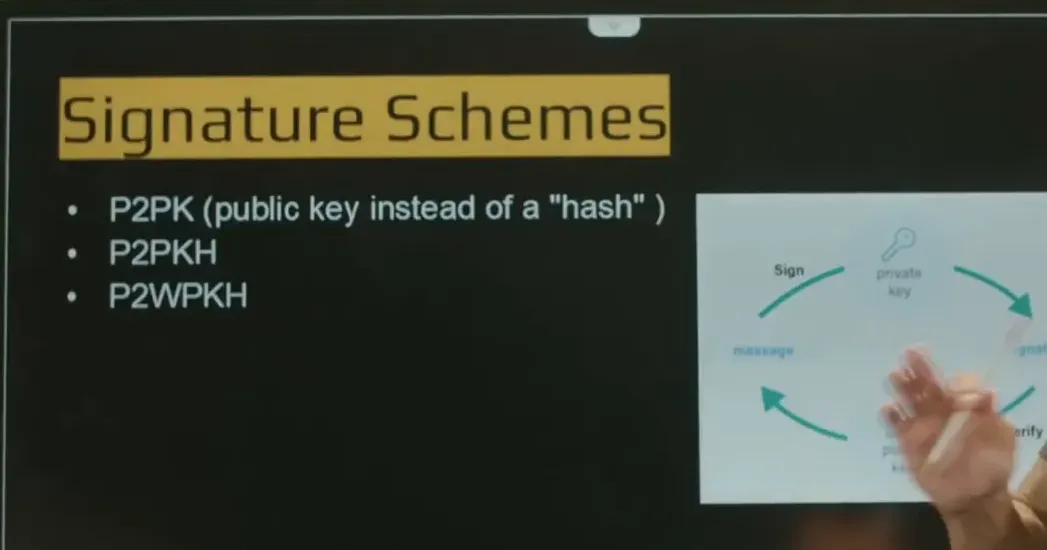
The Evolution of Bitcoin’s Cryptography
Initially, Bitcoin used a scheme called Pay-to-Public-Key (P2PK), where the public key itself was visible on the blockchain. This made the public key susceptible to quantum attacks because if a quantum computer could derive your private key from the public key, your Bitcoin could be stolen.
Later, Bitcoin transitioned to using hashes of the public keys instead of revealing the public keys directly on the blockchain. This is called Pay-to-Public-Key-Hash (P2PKH) and other signature schemes like SegWit and Taproot also use this approach. The hash acts like a shield, hiding the actual public key until you spend from that address.
Why does this matter? Because quantum computers can only attack Bitcoin addresses where the public key is exposed. If the public key is hidden behind a hash, it’s much harder—practically impossible with current or near-future quantum tech—to break the encryption.
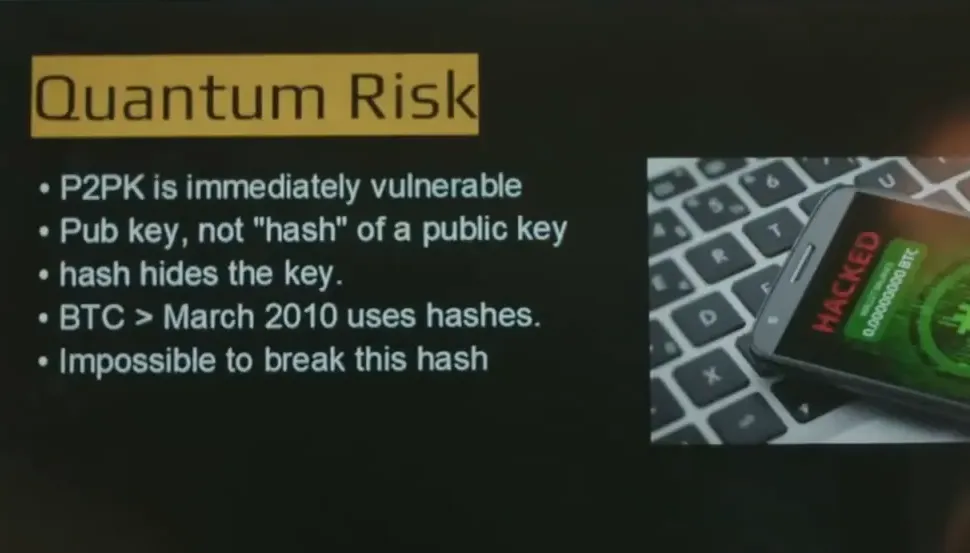
What Part of Bitcoin Is Actually at Risk?
The only Bitcoin at real risk from quantum computing today are those mined during Bitcoin’s early days, before March 2010, when the P2PK scheme was used. During this period, about 1.7 million Bitcoin were mined with public keys openly visible on the blockchain.
However, 95% of those Bitcoins have never moved. It’s likely many owners lost their private keys, making those coins effectively out of circulation. The most notable wallet among these is believed to belong to Bitcoin’s creator, Satoshi Nakamoto, holding about 1.1 million Bitcoin—roughly 5% of the total supply.
At current prices, this stash would make Satoshi the 12th richest person in the world. If quantum computers could break those keys, someone could theoretically steal those coins and dump them on the market, causing a temporary price crash.

How Big Is This Threat?
While this sounds dramatic, the actual threat is limited:
- The vulnerable coins are confined to a specific early period of Bitcoin’s history.
- Most of these coins have not been moved in over a decade, reducing the risk of exposure.
- If quantum computers get powerful enough, the ecosystem can implement measures to mitigate damage.
So while this early Bitcoin is the primary target for quantum attacks, the overall Bitcoin network remains secure.
How to Secure Your Bitcoin from Quantum Attacks
If you happen to own Bitcoin from before March 2010 or have any Bitcoin that might be vulnerable, there are simple solutions to protect yourself:
- Move your coins to a new wallet address. Creating a new wallet address means your public key will not be exposed in the blockchain, making it quantum-resistant.
- Use new wallet addresses every time you spend. By not reusing addresses, you limit the exposure of your public keys.
For example, if you spend Bitcoin from an address and expose its public key, you should transfer any remaining balance to a new address immediately. This practice minimizes risk by ensuring your public keys are only exposed briefly and do not remain vulnerable on the blockchain.
The Hourglass Solution for Early Bitcoin
For the early Bitcoin wallets that cannot be moved immediately or are at risk of being exploited, there’s a concept called the hourglass. This mechanism would limit the rate at which coins could be moved from at-risk wallets—say, no more than one Bitcoin per block—dripping the coins slowly over many years (potentially 120 years).
Such a constraint would prevent a sudden dump of millions of coins on the market, protecting the ecosystem from shocks even if those wallets were compromised by quantum attacks.
Why You Should Always Use New Wallets
Bitcoin’s best security practice, recommended even by Satoshi Nakamoto, is to always use new wallet addresses. Most modern hardware wallets support this feature, allowing users to generate multiple addresses easily.
By using new wallets:
- Your public keys remain hidden until you spend from the address.
- You reduce the risk of quantum attacks targeting your exposed public keys.
- Your Bitcoin holdings remain more secure overall.
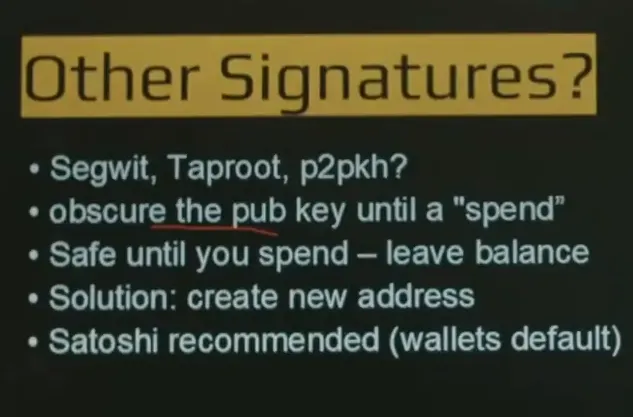
The Importance of Managing Your Own Private Keys
One of Bitcoin’s revolutionary features is that it allows you to be your own bank. You own your private keys, which means you control your Bitcoin without relying on third parties. This is the first time in history that property can be owned in a way that cannot be seized by external forces.
However, this freedom comes with responsibility. You must secure your private keys carefully and follow best practices like using new wallets and moving coins as needed to protect against emerging threats like quantum computing.
If you keep your Bitcoin on exchanges or ETFs, they hold your keys, so you don’t need to worry about this quantum risk personally. But if you self-custody, these precautions are essential.
Is the Lightning Network Safe From Quantum Attacks?
The Lightning Network is a layer-two solution built on top of Bitcoin to enable faster, cheaper, and more private transactions. Naturally, many wonder if quantum computing could break Lightning’s security.
Fortunately, the Lightning Network is relatively safe. The public keys involved in Lightning channels are only revealed when a channel closes. Until then, transactions happen off-chain, and the keys remain hidden.
While future quantum advancements may require some adjustments, the Lightning Network’s design inherently limits quantum exposure, making it a secure method for Bitcoin transactions even in a post-quantum future.
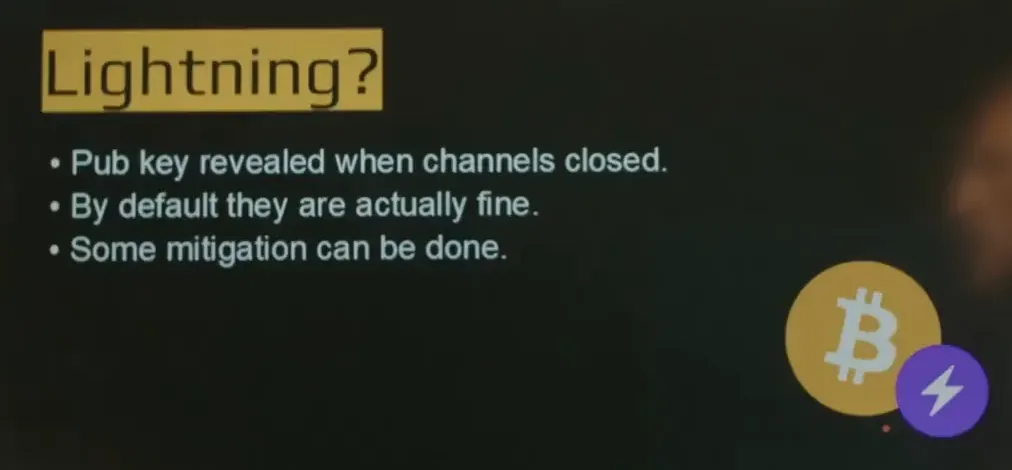
Other Potential Quantum Attack Vectors and Their Solutions
Another area to consider is the Bitcoin mempool, where unconfirmed transactions wait to be processed by miners. During this time, public keys are broadcast and visible, which could theoretically expose them to quantum attacks.
However, such an attack would require immense computational power and a brute force approach, making it highly impractical with current technology.
Moreover, there are solutions to mitigate these risks:
- Transaction Delays: Introducing delays before funds can be moved can reduce the window of vulnerability.
- Quantum-Proof Addresses: Developing and using new address schemes resistant to quantum attacks can future-proof Bitcoin transactions.
None of these scenarios are catastrophic. They represent manageable risks that the Bitcoin community and developers are actively considering.
The Future: Post-Quantum Cryptography and Bitcoin
Bitcoin’s cryptographic schemes have evolved over the years since its launch in 2009. From the original P2PK scheme to P2PKH, SegWit, Taproot, and beyond, the network has adapted to improve security and efficiency.
Looking ahead, new post-quantum cryptographic algorithms are being researched and developed. When quantum computers become a real threat, the Bitcoin network can upgrade to these new schemes, allowing users to migrate their wallets to quantum-resistant addresses.
This upgrade path means that Bitcoin is not static; it can evolve to meet future challenges without catastrophic disruption.

What Should You Do Today to Protect Your Bitcoin?
Here are practical steps you can take now to safeguard your Bitcoin against potential quantum threats:
- Don’t panic. Ignore fear-driven headlines and scams promoting “quantum-resistant tokens.” Bitcoin’s security is robust as long as you follow sensible practices.
- Use new wallets regularly. Avoid reusing old addresses. Spend what you need, then move any remaining balance to a fresh wallet.
- Manage your UTXOs (Unspent Transaction Outputs). Consolidate or move UTXOs into new addresses to keep them safe.
- Think like checking and savings accounts. Keep the bulk of your Bitcoin in cold storage (savings) and only a small amount in “checking” wallets for spending.
By following these simple steps, you can ensure your Bitcoin remains secure, no matter what advances quantum computing brings in the future.
Conclusion: Bitcoin vs. Quantum Computers – The Bottom Line
The narrative that quantum computers will soon break Bitcoin and cause a collapse is largely fear-driven and exaggerated. While the technology poses theoretical risks, the reality is much more nuanced:
- Quantum computing is not here yet and may take a decade or more to reach the capability to threaten Bitcoin.
- Only early Bitcoin mined before 2010 with exposed public keys is potentially vulnerable.
- Most Bitcoin uses quantum-resistant schemes where public keys are hidden behind hashes.
- There are practical, existing solutions to protect vulnerable Bitcoin and mitigate risks.
- The Bitcoin network can upgrade to post-quantum cryptography when needed.
By understanding these facts and following recommended security practices, you can confidently hold and use Bitcoin without fear of an imminent quantum attack. The future of Bitcoin remains bright, secure, and resilient.
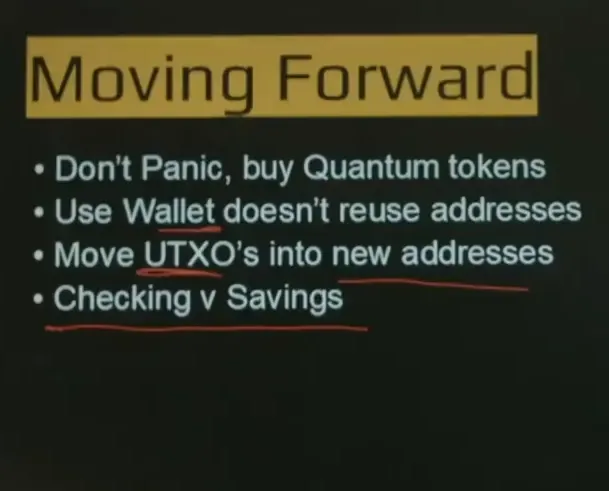
Frequently Asked Questions (FAQ)
1. Can quantum computers currently break Bitcoin’s encryption?
No. Current quantum computers do not have the power to break Bitcoin’s cryptography. It is a theoretical risk for the future, possibly 8 to 10 years or more away.
2. Which Bitcoin addresses are vulnerable to quantum attacks?
Bitcoin addresses created before March 2010 using the Pay-to-Public-Key (P2PK) scheme are vulnerable because their public keys are exposed on the blockchain.
3. How can I protect my Bitcoin from quantum computing threats?
Use new wallet addresses regularly, move coins to fresh wallets after spending, and keep most of your Bitcoin in cold storage. Avoid reusing addresses to minimize exposure.
4. Is the Lightning Network safe from quantum attacks?
Yes, the Lightning Network is designed to minimize exposure of public keys and is considered secure against quantum threats for now.
5. Will Bitcoin upgrade to quantum-resistant cryptography?
Yes, the Bitcoin network can adopt new post-quantum cryptographic algorithms when quantum computing becomes a real threat, allowing users to migrate their wallets accordingly.
6. Should I be worried about scams selling “quantum-resistant” tokens?
No. Many such offerings are scams. Bitcoin itself is quantum-resistant as long as you follow best security practices. Do not fall for fear-based marketing or unproven tokens.
7. What is the “hourglass” solution for early Bitcoin wallets?
The hourglass is a proposed mechanism to limit how quickly coins from vulnerable early wallets can be moved, reducing the risk of a sudden market crash if those coins are compromised.
Understanding the real Bitcoin vs. Quantum Computers story empowers you to protect your assets wisely and avoid panic. Stay informed, stay secure, and keep your Bitcoin safe for the long term.



